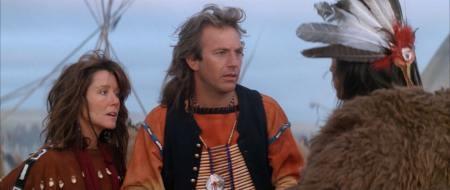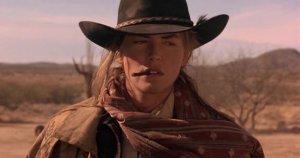Yesterday, a late-night search for something to watch on cable brought me to something truly unexpected: Bad Girls.
It had all the tell-tale signs of a western except instead of a grisly old man riding the horse and saving the girl it was Madeleine Stowe. Suddenly, I remembered what this was: It’s the all-female western featuring Stowe, Drew Berrymore, Andie McDowell, and Mary Stuart Masterson as four prostitutes who do a sort of Thelma & Louise thing through the Old West. I’d never actually seen it before, and I gave it a couple of mediocre minutes before moving on to something else. This brief experience ultimately re-enforced the only two things Bad Girls is really remembered for: 1) Starring Drew Berrymore in a random all-female western; 2) Being pretty bad.
This was a particularly interesting reminder in light of the often-deafening cry for more female-led and targeted entertainment from our movies these days. Women make up the majority of filmgoers, and have been huge contributors to the sustained success currently being experienced by female-led films (Hunger Games, Maleficent, Frozen, The Heat) and ensemble comic book movies (Guardians of the Galaxy). As a result, Hollywood is throwing out at least 2 (Wonder Woman, Captain Marvel) female-led superhero movies by 2018, and Bridesmaids director Paul Feig is busy developing a potential all-female re-make of Ghostbusters. Now, there are rumors that Sony is kicking around something called “Glass Ceiling” – a team-up movie that would bring all of the female Spider-Man characters together, such as Black Cat, Silver Sable, Silk, and Spider-Girl. Feig and Sony aren’t the only ones with designs on an all-female franchise starter. For several years now The Expendables producers have been talking about doing an all-female spin-off called “The Expendabelles,” and writer/director William Butler is trying to do the same for the horror genre, throwing together some of horror’s most infamous “final girls” to take down a male killer.
Not a single one of those all-female projects is actually guaranteed to make it to screen, but if they do will they ultimately be doomed to Bad Girls’ fate, i.e., written off by history as a mere novelty item? And why do we marginalize certain movies like that? FilmSchoolRejects recently provided an interesting answer:
We use [“all female”, “female-led”] because it’s the hook we’ve been fed — the focus-grabbing quirk that will remain a gimmick even if the movie is excellent. Grabbing the public’s attention comes with a cost of singularly defining your project by the thing that excites the marketing department. This is the existential crisis faced by all minority and underserved storytelling groups. Make a movie where a group of men (say, expendable ones?) band together, and no one raises an eyebrow. Make a movie where a group of women do something — especially if the job is seen as “traditionally male” — and you’ll get all the attention you want while running the risk of having your project wholly defined by its novelty.
It’s worth stopping for a moment to take a look back at what exactly led to the creation of Bad Girls in the first place. The western genre experienced a bit of a revival in the late ‘80s into the ‘90s. There hadn’t been a new western film in 3 years by the time Billy the Kid biopic Young Guns arrived in 1988, but it turned into a financial success, finishing just outside of the top 20 films of the year. It was easily written off as not so much a helpful punch in the arm for the genre but instead a triumph of casting, letting all of us gaze longingly at Emilio Estevez, Charlie Sheen, Lou Diamond Phillips, and Kiefer Sutherland in their prime. It was less easy to write off what came next as the following years brought a ginormous hit – Back to the Future III (1989), an inevitable, equally successful sequel – Young Guns 2 (1990), and an unexpected animated entry – An American Tail: Feivel Goes West (1991). The critical and box office winners, however, were easily Kevin Costner’s Dances with Wolves (1990) and Clint Eastwood’s Unforgiven (1992), both of which were nominated for Best Picture (which Wolves won) and made over $100 million domestic.

Final Totals – Dances with Wolves = $184m domestic,$424m worldwide/Unforgiven = $101m domestic,$159m worldwide
Clearly, the call was on for a wave of westerns looking for some of that Young Guns/Dances with Wolves/Unforgiven money, and Hollywood responded by putting out 10 westerns between 1993 and 1994, 6 of them in ’94 alone. It didn’t go well. Mel Gibson and James Garner’s Maverick (1994) was the only hit, with $101m domestic, $183m worldwide. Tombstone might have managed to just break even with $56m domestic against a $25m production budget. Everything else struggled. In fact, Geronimo: An American Legend (1993), Bad Girls, and Wyatt Earp flat out bombed, with the ladder grossing a mere $25m domestic against a $63m production budget. By the time the Sharon Stone-led The Quick and the Dead arrived in early 1995 and grossed $14m below its budget the western revival was dead.
That’s why, for the briefest of moments, there were so many westerns in the early 90s, and it’s also why they fell out of favor by 1995. It doesn’t actually explain why that wave included the all-female Bad Girls and female-led The Quick and the Dead.
Those films presumably owe a bit of their existence to the improbable box office success of Thelma & Louse (1991), but they also came about because of the women who were making them. In the case of Bad Girls, its all-female angle originally extended behind the scenes as well. The original script was written by Yolande Turner (Two to Tango) and Becky Johnston (The Prince of Tides, Seven Years in Tibet), and Tamra Davis was on board to direct, having just made her directorial debut on the film that kicked off Drew Berrymore’s adult acting career, 1992’s Guncrazy. Looking at it from afar, it seems like they were trying to do a female Young Guns, just with a slightly larger age range. They grabbed two young actresses with recent hits (Mary Stuart Masterson & Andie McDowell had just done Fried Green Tomatoes and Groundhog Dog respectively), a potential rising star (Drew Berrymore), and anchored them with a slightly older veteran (Madeleine Stowe). They even cast Young Guns‘ Dermot Mulroney in a supporting role. However, shortly after the start of filming the production company fired Davis, replaced her with Jonathan Kaplan (The Accused), and had Ken Friedman (Cadillac Man) completely re-write the script. Several actors left the project since it no longer resembled what they had signed up for.
 In the case of The Quick & The Dead, Sharon Stone was not just the star but also one of the producers. The actual script came from a man, Simon Moore, who was experimenting with a gender-inverted version of a Sergio Leone western. Once Sony bought the script from Moore they approached Stone to star, less than a year removed at that point from Basic Instinct’s (1992) insane box office run of $352m worldwide. This was the era in Hollywood history in which all of the negotiating power belonged to the star, with studios not just granting obscene contracts and fringe benefits but also shared producing credit to stars. So, Sony made Stone a co-producer, giving her script approval, and ultimately falling in line when she wanted Sam Raimi to direct, Russell Crowe to play the love interest, and Leonardo DiCaprio to play one of the most memorable characters.
In the case of The Quick & The Dead, Sharon Stone was not just the star but also one of the producers. The actual script came from a man, Simon Moore, who was experimenting with a gender-inverted version of a Sergio Leone western. Once Sony bought the script from Moore they approached Stone to star, less than a year removed at that point from Basic Instinct’s (1992) insane box office run of $352m worldwide. This was the era in Hollywood history in which all of the negotiating power belonged to the star, with studios not just granting obscene contracts and fringe benefits but also shared producing credit to stars. So, Sony made Stone a co-producer, giving her script approval, and ultimately falling in line when she wanted Sam Raimi to direct, Russell Crowe to play the love interest, and Leonardo DiCaprio to play one of the most memorable characters.
Of course, that all resulted in two box office bombs, making them to the western genre what Catwoman and Elektra have been to the comic book genre. The financial failings of both Bad Girls and The Quick & The Dead didn’t just contribute to the death spiral of a short-lived western revival, though. By that point, there still had been very, very few action heroine movies, especially if you take away Sigourney Weaver’s first three Alien films. 1995 delivered 3 such movies, all of them notorious bombs. In addition to The Quick & The Dead, there was the Lori Petty-led Tank Girl and Geena Davis-led Cutthroat Island, which bankrupted its production company and remains possibly the biggest box office bomb of all time.
I remember all of them because the fact that they were led by women still stands out. However, I remember Tank Girl and Cutthroat Island more for their status as legendary bombs; I remember Bad Girls for its gimmick. Before this morning, I had no clue how well it did or did not do at the box office (it made $15m domestic); I just knew it was that all-female western. Will I think the same of any future all-female Ghostbusters or Spider-Man? I, again, turn to FilmSchoolRejects:
Defining a movie like this upfront by its inherent socio-political element is a good way to turn off the ears of the very people who need to hear your message […] For me, a return to normalcy with an increased amount, awareness and respect for female-led movies isn’t going to be achieved by brute force. Regardless of how a new Ghostbusters turns out (if it gets made), it will always be anchored by this limiting identity. Its femininity will be the first question every interviewer asks for a year. Instead of the scope of the adventure or the quirks of its characters, this will be the story.
That’s undeniably true. However, when I think of it in application to how we know remember Bad Girls I can’t help but wonder what would have happened if Bad Girls or Quick and the Dead had actually made a lot of money. Wouldn’t that have led to an inevitable wave of knock-offs? If so, would such films still feel like novelties after there were quite a few more of them? Are the all-female Ghostubsters and all super heroine-Spider-Man projects doomed to Bad Girls‘ fate, forever singularly defined by their gimmick? Or is that merely the fate which awaits a film that fails to inspire a wave of imitators? We’ll soon find out. Maybe. If any of these new “all female” projects actually get made.
What do you think? Has this topic already been covered to death by this point? Have you seen Bad Girls, and think it’s super fantastic? Let us know in the comments.

